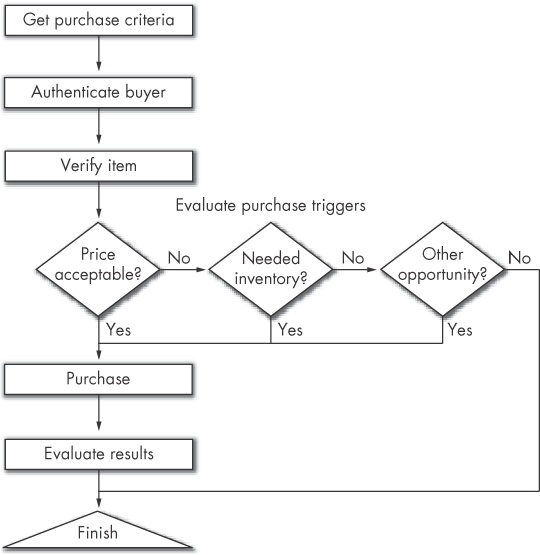A procurement bot is any intelligent web agent that automatically makes online purchases on a user’s behalf. These webbots are improvements over manual online procurement because they not only automate the online purchasing process, but also autonomously detect events that indicate the best time to buy. Procurement bots commonly make automated purchases based on the availability of merchandise or price reductions. For other webbots, external events like low inventory levels trigger a purchase.
The advantage of using procurement bots in your business is that they identify opportunities that may only be available for a short period or that may only be discovered after many hours of browsing. Manually finding online deals can be tedious, time consuming, and prone to human error. The ability to shop automatically uncovers bargains that would otherwise go unnoticed. I’ve written automated procurement bots that—on a monthly basis—purchase hundreds of thousands of dollars of merchandise that would be unknown to less vigilant human buyers.
Before you begin, consider that procurement bots require both planning and in-depth investigation of target websites. These programs spend your (or your clients’) money, and their success is dependent on how well you design, program, debug, and implement them. With this in mind, use the techniques described elsewhere in this book before embarking on your first procurement bot—in other words, your first webbot shouldn’t be one that spends money. You can use the online test store (introduced in Chapter 8) as target practice before writing webbots that make autonomous purchases in the wild.
While procurement bots purchase a wide range of products in various circumstances, they typically follow the steps shown in Figure 18-1.
While price and need govern this particular webbot in deciding when to make a purchase, you can design virtually any type of procurement bot by substituting different purchase trigger events.
A procurement bot first needs to gather the purchase criteria, which is a description of the item or items to purchase. The purchase criteria may range from simple part numbers to item descriptions combined with complicated calculations that determine how much you want to pay for an item.
Once the webbot has identified the purchase criteria, it authenticates the buyer by automatically logging in to the online store as a registered user. In almost all cases, this means the webbot must know the username and password of the person it represents.[56] (For more on how webbots handle the authentication process, see Chapter 20.)
Prior to purchase, procurement bots should verify that requested items are still available for sale if they were selected in advance of the actual purchase. For example, if you instruct a procurement bot to buy something in an online auction, the bot should email you if the auction is canceled and the item is no longer for sale. (Chapter 15 describes how to send email from a webbot.) The procurement process should also stop at this point. This sounds obvious, but unless you program your webbot to stop when items are no longer for sale, it may attempt to purchase unavailable items.
Purchase triggers determine when available merchandise meets predefined purchase criteria. When those conditions are met, the purchase is made. Bear in mind that it may take days, weeks, or even months before a buying opportunity presents itself. But when it does, you’ll be the first in line (unless someone who is also running a procurement bot beats you to it).[57]
Together, the purchase criteria and purchase triggers define what your procurement bot does. If you want to pick up cheap merchandise or capitalize on price reductions, you might use price as a trigger. More complicated webbots may weigh both price and inventory levels to make purchasing decisions. Other procurement bots may make purchases based on the scarcity of merchandise. Alternatively, as we’ll explore later, you may write a sniper, which uses the time an auction ends as a trigger to bidding.
Purchases are finalized by completing and submitting forms that collect information about the purchased product, shipping address, and payment method. Your webbot should submit these forms in the same manner as described earlier in this book. (See Chapter 6 for more on writing webbots that submit forms to websites.)
After making a purchase, the target server will display a web page that confirms your purchase. Your webbot should parse the page to determine that your acquisition was successful and then communicate the result of the purchase to you. Notifications of this type are usually done through email. If the procurement bot buys many items, however, it might be better to report the status of all purchases on a web page or to send an email with the consolidated results for the entire day’s activity.
[56] The exceptions to this rule are instances like the eBay API, which allow third parties to act on someone’s behalf without knowing that individual’s username and password.
[57] Occasionally, you may find yourself in direct competition with other webbots. I’ve found that when this happens, it’s usually best not to get overly competitive and do things like use excessive bandwidth or server connections that might identify your presence.
